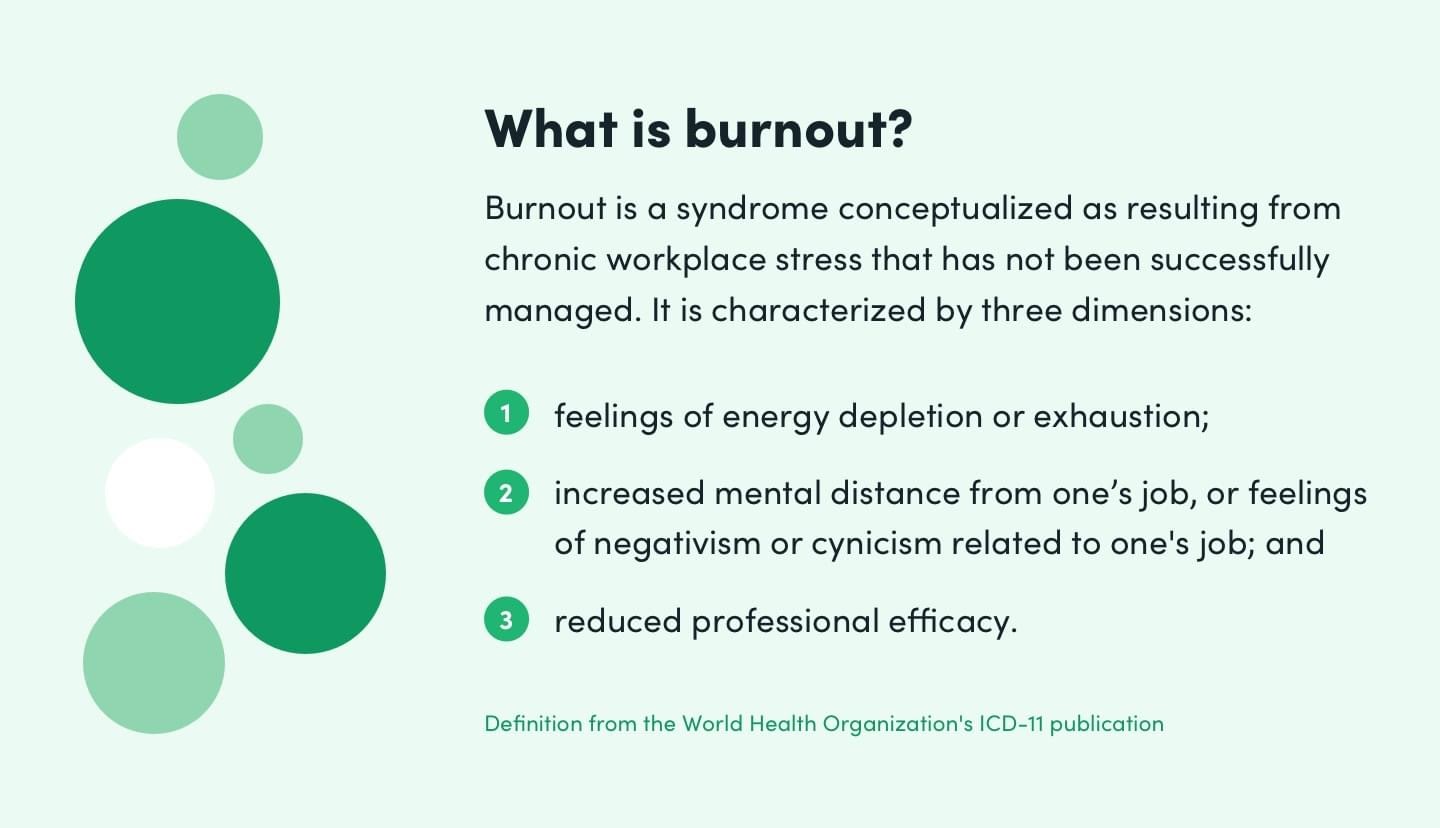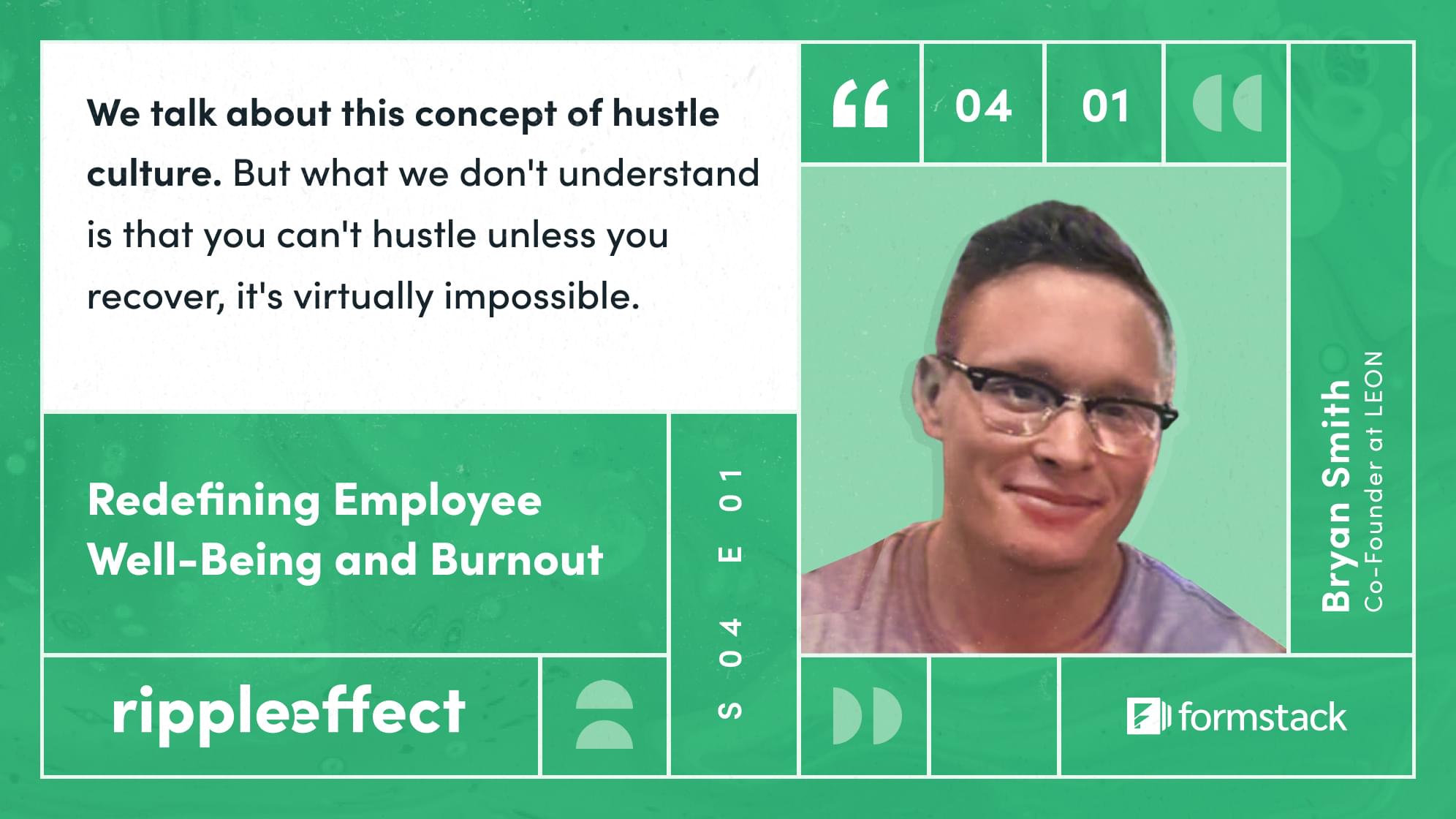Burnout.
The word has become a very common part of workplace vernacular. From the often-cited Harvard Business Review article Beyond Burned Out to #burnout being used an average of 415 times on Twitter per day, burnout is a topic we can’t seem to avoid.
.png)
Yet burnout is not a new topic. In fact, it was added to the 10th issue of the International Classification of Diseases (ICD-10), which was published in 1990. This document, produced by the World Health Organization (WHO), acts as the global standard for coding information about diseases and causes of death.
Those who have doubted the impact of burnout can no longer ignore it. It has become a widespread affliction, compounded by COVID-19, an abundance of change fatigue, and the stresses of the modern workplace. According to a 2020 study, three out of four U.S. workers consider themselves burned out. Some people even claim burnout has taken over an entire generation.
In an episode of Formstack’s Ripple Effect podcast, workplace wellness expert Bryan Smith of LEON joined us to discuss burnout in-depth. Below, we dig into what burnout is, why it is increasing, and how Bryan reduces it with a few key strategies.

Rather listen? Hear Bryan’s entire Ripple Effect episode, Redefining Employee Well-being and Burnout, now.
What is burnout?
Although included in the ICD-10, burnout is not classified as a medical condition. It is considered an occupational phenomenon. According to WHO, burnout is defined in the ICD-11 as:

According to the ICD-11, burnout is a phenomenon specifically tied to occupation and should not be used to describe experiences outside the workplace. Burnout became a topic of research in the workplace in the ‘70s and ‘80s, popularized by Dr. Herbert J. Freudenberger. He went on to write one of the first books on burnout, titled “Burnout: The High Cost of High Achievement,” published in 1981.
Overall, burnout has a massive impact on your ability to think, focus, and feel motivated. UC Berkeley psychologist Christina Maslach helped legitimize burnout by creating the Maslach Burnout Inventory, which provided a way to measure its symptoms. According to the University of California, “the assessment is organized around three measurable elements: emotional exhaustion, depersonalization and (a lack of) personal accomplishment. In the burned-out person, those translate to exhaustion, negativity or cynicism, and a sense of professional ineffectiveness.”
How does burnout affect people?
WHO may not classify burnout as a medical condition, but don’t think that means it does not cause physiological symptoms. As Bryan explains in his Ripple Effect episode, burnout has a direct impact on your physical health and well-being.
“Everything that we've taken into account of what burnout is from a clinical level has been, most of the time, dictated by organizational psychologists or psychiatrists. It's a psychological problem and a physiological problem.”
As the New York Times points out, burnout is much more than just emotional exhaustion. It has a major impact on your mental and physical health as well. Bryan wants people to understand that burnout doesn’t impact just one area of life—it can have drastic effects on all areas of your life.
What can you do to avoid burnout?
Because burnout is created within the workplace, the only way to reduce burnout is through analyzing your work environment. This may require some drastic changes within your organization, especially if people do not realize the level or impact of burnout around them.
Bryan brings up the fact that organizations should always put the health and well-being of employees first. This is a key way to avoid, and possibly eliminate, burnout.
If your work environment creates a high level of burnout, here are some ideas on how to combat it and reduce it over time. These tips are best for managers to enact, but if you don’t manage people, you may suggest these ideas to management to begin implementing.
Empower Individuals
“The way that I achieve wellness might be very, very different from the way that you achieve wellness. We should create a conversation about how people are going about managing their health in their own way, rather than forcing everybody into the same strategy.”
Humans are incredibly diverse individuals who all handle and react to stress differently. This is important to keep in mind when considering what wellness strategies to implement in the workplace.
Bryan is adamant about avoiding one-size-fits-all strategies when trying to minimize or prevent burnout. He emphasizes that one strategy may work well for a handful of employees, but it may not be the best fit for others.
The best way to support employees in battling stress, exhaustion, and burnout is through a wide variety of wellness programs and strategies. You may find that some employees enjoy having a coaching service available to handle stress, while others may seek physical fitness. Try offering several types of perks, benefits, and wellness opportunities for employees so they can create their own plan for combating burnout.
Provide Recovery Time
“Let's say your team is trending towards burnout. Maybe next month you just decrease OKRs just a little to allow them to recover. Not so much that it's going to affect your company, but enough that allows them to take a breath. And now that they're recovered, we ramp up a little bit more—not enough to put them back into that fight-or-flight response, but enough that it makes them stretch a little bit because now they are recovered.”
Have you ever thought of your employees as athletes? According to Bryan, you should. He covers an array of ways employees are like athletes, but one major one he discusses is that employees need time to recover, just like athletes do.
Consider the end-of-quarter time crunch for a sales team. This time period is always incredibly hectic and stressful, chock full of last-minute meetings, contract reviews, and final pushes to close out the quarter strong. It’s a lot to handle, and it takes a lot of energy and focus to accomplish.
Once the end of quarter is completed, many sales teams don’t have much left in the tank to just carry on at the same level or capacity. When they are not given time to recover, they wear themselves out completely, leading to intense burnout.

Without any time to rest, recoup, and recover, employees are drained of energy, motivation, and ability. It’s important to go through cycles of hard work that are followed by times of recovery to ensure employees don’t completely burn themselves out by pushing too hard, too often.
Recovery can look very different across people, teams, and organizations. It may include taking an afternoon off, switching to a different type of work or project, or lowering quotes for a week or two to provide some breathing space. At the end of the day, it’s most important to pay attention to the overall health, well-being, and stress levels of your team so you can be proactive in adjusting workloads, timelines, and expectations.
Adjust to Stress Levels
“Let's bring the people that need support up at the right time with the right strategy. And let's make sure that employees that are highly recovered, let's push them a little harder because we know they can handle the stress. If we give them the proper dose of stress, they're going to become better high performers.”
Going back to Bryan's comparison of employees and athletes, it's not just about the importance of a recovery period. To reach their full potential, athletes (and employees) also need to be pushed when they've met their needed recovery time.Stress isn’t always bad; it can lead to important growth and achievement when people have capacity to handle it.
Yet getting a good grasp on an employee’s capacity to take on stress includes more than just understanding their current workload. Their work schedule and projects play a big role in what they’re able to tackle, but you have to consider external factors as well.
Focus on building a work environment that encourages transparency and honesty. Some employees may not want to open up about their circumstances outside of work, but always make it an option for them to turn to you and explain what they are handling outside their job. There may be times of high stress at home that impact their ability to handle additional stress at work.
When you’re in sync with these changes and fluctuations, you can better understand the capacity of employees and designate work accordingly to adjust to the needs of your team.
Say Goodbye to Burnout
It’s probably impossible to eliminate burnout completely, but by applying some of the strategies above, you can help your employees drastically reduce it. We all want to be healthy, happy, and fulfilled at work, and keeping burnout at bay is one great way to help create a better work environment for all.
Listen to Bryan’s Ripple Effect podcast episode Redefining Employee Well-being and Burnout now to discover even more helpful tips on how to reduce burnout and build a better work environment.











